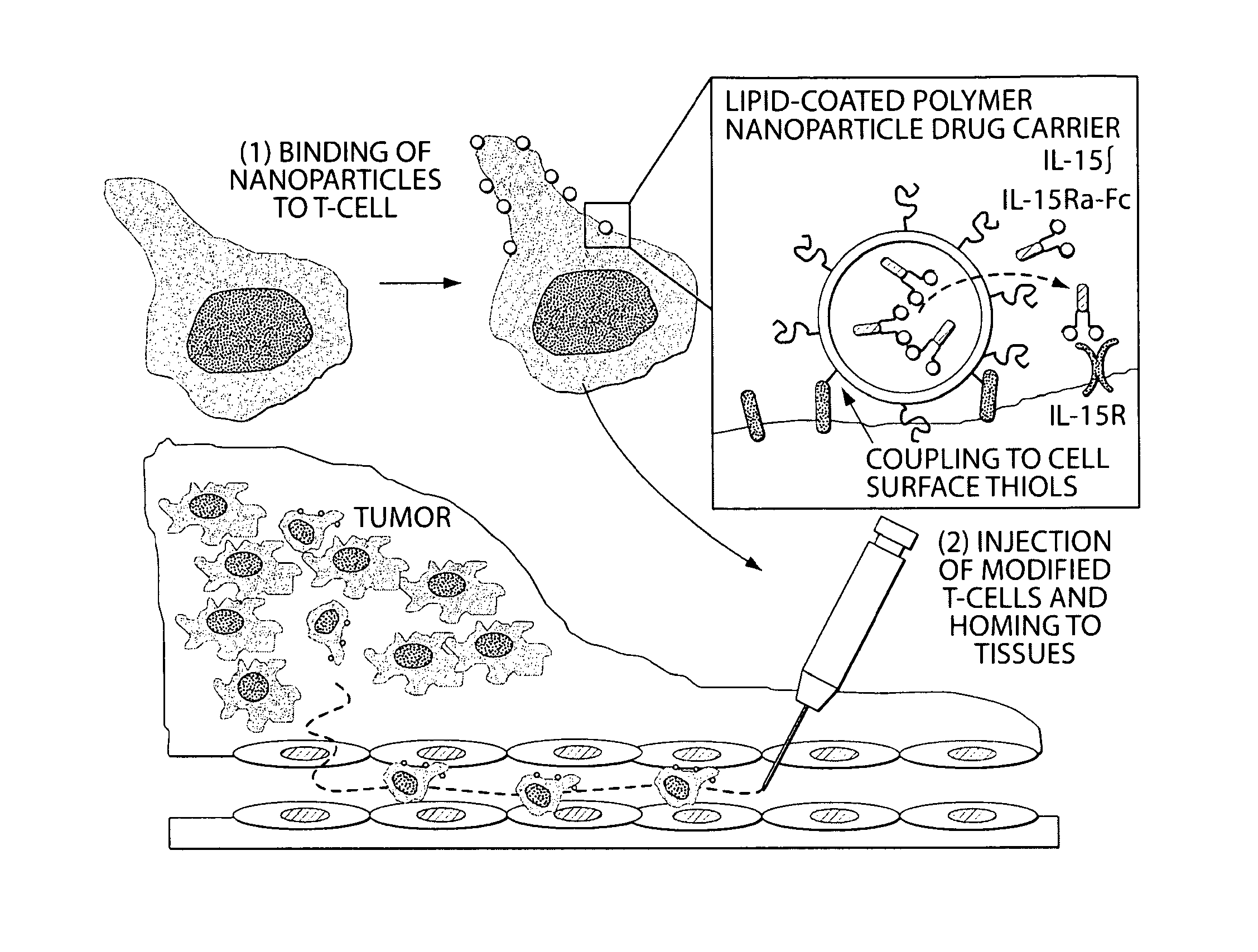Methods and compositions for localized agent delivery
a localized agent and composition technology, applied in the field of localized agent delivery, can solve the problems of reducing the effect of dna/rna fragmentation, reducing the risk of infection, and causing cell death, so as to facilitate conjugation and reduce the risk of infection.
- Summary
- Abstract
- Description
- Claims
- Application Information
AI Technical Summary
Benefits of technology
Problems solved by technology
Method used
Image
Examples
example 1
Nanoparticle Synthesis, Characterization and Conjugation to T Cells
[0172]1.1. Nanoparticle Synthesis. We recently developed a strategy to prepare ‘lipid-enveloped’ biodegradable polymer nanoparticles. (Bershteyn A et al., Soft Matter 4: 1787, 2008.) These particles have a biodegradable poly(lactide-co-glycolide) core and a surface coating of a phospholipid bilayer (FIGS. 2A and B, arrows). These nanoparticles can encapsulate drug molecules in their core and / or incorporate drugs in the surface lipid bilayer, enabling sustained release of proteins, peptides, or small-molecule compounds. Nanoparticles were synthesized by a double emulsion / solvent evaporation process: 200 μL water was emulsified in 1 mL chloroform containing 2 mg of a lipid mixture (4:1 mole:mole DOPC:DOPG with varying quantities of dioleoyl maleimidophenyl phosphoethanolamine (MPB PE), with or without 25 μg 1,1′-dioctacdecyl-3,3,3′,3′-tetramethylindodicarbocyanine (DiD) or DiR lipid-like fluorescent dye (Invitrogen)) a...
example 2
Assessment of Nanoparticle Binding on T Cell Functions
[0185]2.1. Nanoparticles Bound to Cells Do Not Block Antigen Recognition or T Cell Proliferation. Having found that thiol coupling allowed stable non-toxic linkage of nanoparticles to cells, we next sought to determine whether the coupling reaction interfered with T cell behavior, and to find what dose of nanoparticles could be attached to T cells without blocking key T cell functions. We first tested whether T cell proliferation was impacted by nanoparticle coupling. Pmel-1 T cells were primed / expanded in vitro with anti-CD3 / anti-CD28 beads and IL-2 as described above. The expanded cells were labeled with carboxyfluorescein succinimidyl ester (CFSE), and incubated with 2500 DiD-labeled lipid-coated PLGA nanoparticles per cell for conjugation. In parallel, day 6 bone marrow-derived dendritic cells from C57Bl / 6 mice prepared as described (Stachowiak et al., J Immunol 177(4): 2340, 2006) were activated by incubation with 1 μM CpG o...
example 3
Cytokine / Drug Loading in Lipid-Coated PLGA Nanoparticles
[0190]Nanoparticles are conjugated to ACT T cells in two different ways: (i) nanoparticles are loaded with cytokines designed to act on the carrier T cells themselves to support their proliferation, survival and effector function (e.g., IL-15 superagonist) or (ii) nanoparticles will be used to deliver compounds designed to act on other cells in the microenvironment, including Toll-like receptor (TLR) ligands and vaccine antigens (e.g., imiquimod or MPLA). In the previous studies, ‘empty’ nanoparticles were used to assess the impact of particle conjugation on T cell functions. Here we tested the encapsulation / incorporation of proteins (e.g., IL-15 superagonist) and TLR ligands into the nanoparticles, in order to deliver therapeutically relevant cargos.
[0191]PLGA nanoparticles have been explored in numerous prior studies as vehicles for encapsulation and delivery of proteins, peptides, and small molecule drug compounds, and notab...
PUM
| Property | Measurement | Unit |
|---|---|---|
| Diameter | aaaaa | aaaaa |
| Biodegradability | aaaaa | aaaaa |
Abstract
Description
Claims
Application Information
 Login to View More
Login to View More - R&D
- Intellectual Property
- Life Sciences
- Materials
- Tech Scout
- Unparalleled Data Quality
- Higher Quality Content
- 60% Fewer Hallucinations
Browse by: Latest US Patents, China's latest patents, Technical Efficacy Thesaurus, Application Domain, Technology Topic, Popular Technical Reports.
© 2025 PatSnap. All rights reserved.Legal|Privacy policy|Modern Slavery Act Transparency Statement|Sitemap|About US| Contact US: help@patsnap.com



